Cisco CP-7861-K9 User Manual

Cisco IP Phone 7821, 7841, and 7861 User Guide for Cisco Unified Communications Manager 10.0 (SIP)
First Published: October 25, 2013
Last Modified: September 19, 2014
Americas Headquarters
Cisco Systems, Inc. 170 West Tasman Drive
San Jose, CA 95134-1706 USA http://www.cisco.com Tel: 408 526-4000
800 553-NETS (6387) Fax: 408 527-0883
THE SPECIFICATIONS AND INFORMATION REGARDING THE PRODUCTS IN THIS MANUAL ARE SUBJECT TO CHANGE WITHOUT NOTICE. ALL STATEMENTS, INFORMATION, AND RECOMMENDATIONS IN THIS MANUAL ARE BELIEVED TO BE ACCURATE BUT ARE PRESENTED WITHOUT WARRANTY OF ANY KIND, EXPRESS OR IMPLIED. USERS MUST TAKE FULL RESPONSIBILITY FOR THEIR APPLICATION OF ANY PRODUCTS.
THE SOFTWARE LICENSE AND LIMITED WARRANTY FOR THE ACCOMPANYING PRODUCT ARE SET FORTH IN THE INFORMATION PACKET THAT SHIPPED WITH THE PRODUCT AND ARE INCORPORATED HEREIN BY THIS REFERENCE. IF YOU ARE UNABLE TO LOCATE THE SOFTWARE LICENSE OR LIMITED WARRANTY, CONTACT YOUR CISCO REPRESENTATIVE FOR A COPY.
The following information is for FCC compliance of Class A devices: This equipment has been tested and found to comply with the limits for a Class A digital device, pursuant to part 15 of the FCC rules. These limits are designed to provide reasonable protection against harmful interference when the equipment is operated in a commercial environment. This equipment generates, uses, and can radiate radio-frequency energy and, if not installed and used in accordance with the instruction manual, may cause harmful interference to radio communications. Operation of this equipment in a residential area is likely to cause harmful interference, in which case users will be required to correct the interference at their own expense.
The following information is for FCC compliance of Class B devices: This equipment has been tested and found to comply with the limits for a Class B digital device, pursuant to part 15 of the FCC rules. These limits are designed to provide reasonable protection against harmful interference in a residential installation. This equipment generates, uses and can radiate radio frequency energy and, if not installed and used in accordance with the instructions, may cause harmful interference to radio communications. However, there is no guarantee that interference will not occur in a particular installation. If the equipment causes interference to radio or television reception, which can be determined by turning the equipment off and on, users are encouraged to try to correct the interference by using one or more of the following measures:
•
•
•
•
Reorient or relocate the receiving antenna.
Increase the separation between the equipment and receiver.
Connect the equipment into an outlet on a circuit different from that to which the receiver is connected.
Consult the dealer or an experienced radio/TV technician for help.
Modifications to this product not authorized by Cisco could void the FCC approval and negate your authority to operate the product
The Cisco implementation of TCP header compression is an adaptation of a program developed by the University of California, Berkeley (UCB) as part of UCB’s public domain version of the UNIX operating system. All rights reserved. Copyright © 1981, Regents of the University of California.
NOTWITHSTANDING ANY OTHER WARRANTY HEREIN, ALL DOCUMENT FILES AND SOFTWARE OF THESE SUPPLIERS ARE PROVIDED "AS IS" WITH ALL FAULTS. CISCO AND THE ABOVE-NAMED SUPPLIERS DISCLAIM ALL WARRANTIES, EXPRESSED OR IMPLIED, INCLUDING, WITHOUT LIMITATION, THOSE OF MERCHANTABILITY, FITNESS FOR A PARTICULAR PURPOSE AND NONINFRINGEMENT OR ARISING FROM A COURSE OF DEALING, USAGE, OR TRADE PRACTICE.
IN NO EVENT SHALL CISCO OR ITS SUPPLIERS BE LIABLE FOR ANY INDIRECT, SPECIAL, CONSEQUENTIAL, OR INCIDENTAL DAMAGES, INCLUDING, WITHOUT LIMITATION, LOST PROFITS OR LOSS OR DAMAGE TO DATA ARISING OUT OF THE USE OR INABILITY TO USE THIS MANUAL, EVEN IF CISCO OR ITS SUPPLIERS HAVE BEEN ADVISED OF THE POSSIBILITY OF SUCH DAMAGES.
Any Internet Protocol (IP) addresses and phone numbers used in this document are not intended to be actual addresses and phone numbers. Any examples, command display output, network topology diagrams, and other figures included in the document are shown for illustrative purposes only. Any use of actual IP addresses or phone numbers in illustrative content is unintentional and coincidental.
Cisco and the Cisco logo are trademarks or registered trademarks of Cisco and/or its affiliates in the U.S. and other countries. To view a list of Cisco trademarks, go to this URL: http:// www.cisco.com/go/trademarks. Third-party trademarks mentioned are the property of their respective owners. The use of the word partner does not imply a partnership relationship between Cisco and any other company. (1110R)
© 2014 Cisco Systems, Inc. All rights reserved.

C O N T E N T S
C H A P T E R 1 |
Getting Started 1 |
Accessibility Features 1
Cisco IP Phone 7821 1
Phone Connections 1
Buttons and Hardware 3
Phone Screen 6
Cisco IP Phone 7841 6
Phone Connections 6
Buttons and Hardware 8
Phone Screen 11
Cisco IP Phone 7861 11
Phone Connections 11
Buttons and Hardware 13
Phone Screen 15
Power Requirements 16
Power Save and Power Save Plus 16
Power Save 16
Power Save Plus 16
Additional Information 17
C H A P T E R 2 |
Phone Setup 19 |
Connect Footstand 19
Adjust the Handset Rest 19
C H A P T E R 3 |
Basic Operations 21 |
Clean the Phone Display 21
Make Calls 22
Predial a Number 22
Cisco IP Phone 7821, 7841, and 7861 User Guide for Cisco Unified Communications Manager 10.0 (SIP)
iii

Contents
Place a Call Using the Speakerphone 22
Place a Call Using a Headset 23
Release a Call and Start Another Call 23
Dial an International Number 23
Redial a Number 24
Answer Calls 24
Answer Call Using PickUp 24
Answer Call Using Group PickUp and Group PickUp Number 24
Answer Call Using Group PickUp and Phone Number 25
Answer a Call Using Other PickUp |
25 |
|
|
Automatically Answer Calls 25 |
|
|
|
Respond to Call Waiting Notification |
26 |
|
|
Manage Calls 27 |
|
|
|
Divert a Call 27 |
|
|
|
Forward All Calls 27 |
|
|
|
Transfer a Call to Another Number |
28 |
|
|
Swap Between Calls 28 |
|
|
|
Mute Phone 29 |
|
|
|
Monitor and Record Calls |
29 |
|
|
Hold Calls 29 |
|
|
|
Swap Between Active and Held Calls 29 |
|
||
Put a Call on Hold by Answering a New Call |
29 |
||
Respond to a Hold Reversion Notification 30 |
|
||
Determine If A Shared Line Is On Hold 30 |
|
||
Remote Hold 30 |
|
|
|
Setup Call Back Notification 30 |
|
|
|
Call Park 31 |
|
|
|
Park a Call Using Assisted Directed Call Park |
31 |
||
Park a Call Using Manual Directed Call Park |
32 |
||
Manage Intercom Calls 32 |
|
|
|
Place a Dedicated Intercom Call 32 |
|
|
|
Place a Dialable Intercom Call 33 |
|
|
|
Receive Intercom Call |
33 |
|
|
View Phone Information |
33 |
|
|
Sign In To the Cisco Unified Communications Self Care Portal 34
Cisco IP Phone 7821, 7841, and 7861 User Guide for Cisco Unified Communications Manager 10.0 (SIP)
iv

Contents
C H A P T E R |
4 |
Contacts 35 |
|
|
|
|
|
|
Corporate Directory 35 |
|
|
|
|
|
|
Dial Contact from Search 35 |
|
|
||
|
|
Search and Dial While on Call |
36 |
|
||
|
|
Personal Directory |
36 |
|
|
|
|
|
Add Personal Directory Entry |
37 |
|
||
|
|
Edit Personal Directory Entry |
37 |
|
||
|
|
Delete Personal Directory Entry 37 |
|
|||
|
|
Sign In and Out of Personal Directory |
38 |
|||
|
|
Dial Number from Personal Directory |
38 |
|||
|
|
Search for Entry in Personal Directory |
38 |
|||
|
|
Fast-Dial Codes with Personal Directory |
39 |
|||
|
|
Assign Fast-Dial Code to Personal Directory Entry 39 |
||||
|
|
Place Call Using Fast-Dial Code 39 |
|
|||
|
|
Delete Fast-Dial Code 40 |
|
|
||
|
|
Cisco WebDialer 40 |
|
|
|
|
|
|
Use Cisco WebDialer with Another Online Corporate Directory 40 |
||||
|
|
Change Cisco WebDialer Preferences |
40 |
|||
|
|
Sign Out of Cisco WebDialer |
41 |
|
||
|
|
Call History 43 |
|
|
|
|
C H A P T E R |
5 |
|
|
|
|
|
|
|
Call History Overview 43 |
|
|
|
|
|
|
View Call History |
44 |
|
|
|
|
|
View Call Record Details |
44 |
|
|
|
|
|
Filter Call History |
44 |
|
|
|
|
|
Dial From Call History 45 |
|
|
|
|
|
|
Edit Phone Number 45 |
|
|
|
|
|
|
Clear Call History |
46 |
|
|
|
|
|
Delete Call Record |
46 |
|
|
|
|
|
Voicemail 47 |
|
|
|
|
C H A P T E R |
6 |
|
|
|
|
|
|
|
Voicemail Overview 47 |
|
|
|
|
|
|
Check for Voice Messages |
47 |
|
|
|
|
|
Access Voicemail |
48 |
|
|
|
Cisco IP Phone 7821, 7841, and 7861 User Guide for Cisco Unified Communications Manager 10.0 (SIP)
v

Contents
Listen to Voice Messages 48
C H A P T E R 7
Calling Features |
49 |
|
|
|
|
Conference |
49 |
|
|
|
|
Add Third Party to Conference |
50 |
|
|||
Combine Calls to Create Conference |
50 |
||||
Swap Between Calls Before Completing a Conference 50 |
|||||
View Conference Participants 51 |
|
||||
Remove Conference Participant |
51 |
|
|||
Meet Me Conference 51 |
|
|
|
|
|
Host a Meet Me Conference |
51 |
|
|
||
Join a Meet Me Conference |
52 |
|
|
||
Speed Dial |
52 |
|
|
|
|
Pause in Speed Dial 52 |
|
|
|
|
|
Place Call Using Speed-Dial Codes |
53 |
||||
Multilevel Precedence and Preemption |
54 |
||||
Make Priority Call with Login Required 55 |
|||||
Make Priority Call Without Login 55 |
|||||
Do Not Disturb 56 |
|
|
|
|
|
Turn DND On and Off |
56 |
|
|
|
|
Line Status |
56 |
|
|
|
|
Malicious Call Identification 57 |
|
|
|||
Trace Suspicious Call 57 |
|
|
|
||
Cisco Extension Mobility |
57 |
|
|
|
|
Enable Extension Mobility |
58 |
|
|
||
Mobile Connect 58 |
|
|
|
|
|
Enable Mobile Connect |
59 |
|
|
|
|
Turn Mobile Connect On or Off for All Remote Destinations from a Desk Phone 59
Switch a Desk Phone Call to a Mobile Phone 59
Switch a Mobile Call to the Desk Phone 60
Hand Off a Call from a Mobile Phone to the Desk Phone 60
Hunt Groups 60
Sign In and Out of a Hunt Group 60
Display Queue Statistics 61 cBarge 61
Cisco IP Phone 7821, 7841, and 7861 User Guide for Cisco Unified Communications Manager 10.0 (SIP)
vi

Contents
|
|
Join Conference on Shared Line |
61 |
||
|
|
Extension Mobility 61 |
|
|
|
|
|
Enable Extension Mobility |
62 |
||
|
|
Advanced Operations |
63 |
|
|
C H A P T E R |
8 |
|
|
||
|
|
Call Functions 63 |
|
|
|
|
|
Agent Greeting |
63 |
|
|
|
|
Answer 63 |
|
|
|
|
|
Client Matter Code 64 |
|
|
|
|
|
Forced Authorization Code |
64 |
|
|
|
|
Secure and Nonsecure Indication Tones 64 |
|||
|
|
Shared Lines 65 |
|
|
|
|
|
Feature Buttons and Softkeys |
65 |
|
|
|
|
Survivable Remote Site Telephony Overview 67 |
|||
|
|
Preferences 71 |
|
|
|
C H A P T E R |
9 |
|
|
|
|
|
|
Adjust Brightness |
71 |
|
|
|
|
Adjust Headset Sidetone 71 |
|
|
|
|
|
Change Ringtone |
72 |
|
|
|
|
Line Settings 72 |
|
|
|
|
|
Phone Services 73 |
|
|
|
|
Frequently Asked Questions 75 |
|
|
C H A P T E R |
1 0 |
|
|
|
|
|
Frequently Asked Questions 75 |
|
|
|
|
Troubleshooting 77 |
|
|
C H A P T E R |
1 1 |
|
|
|
|
|
Conference Button and Softkey Unresponsive 77 |
||
|
|
Meet Me Conference Busy Tone |
77 |
|
|
|
Cannot Sign In to Personal Directory |
78 |
|
|
|
No Caller ID on Remote Hold 78 |
|
|
|
|
Cannot Access Self Care Portal |
78 |
|
|
|
Security Error Message 79 |
|
|
|
|
Product Safety and Security 81 |
|
|
C H A P T E R |
1 2 |
|
|
|
|
|
Safety and Performance Information |
81 |
|
Cisco IP Phone 7821, 7841, and 7861 User Guide for Cisco Unified Communications Manager 10.0 (SIP)
vii

Contents
C H A P T E R 1 3
Power Outage 81
External Devices 81
Bluetooth Wireless Headset Performance 82
Power Information 82
FCC Compliance Statements 82
FCC Part 15.21 Statement 82
FCC RF Radiation Exposure Statement 82
FCC Receivers and Class B Digital Statement 83
Cisco Product Security Overview 83
Warranty 85
Cisco One-Year Limited Hardware Warranty Terms 85
Cisco IP Phone 7821, 7841, and 7861 User Guide for Cisco Unified Communications Manager 10.0 (SIP)
viii

C H A P T E R 1
Getting Started
• Accessibility Features, page 1
• Cisco IP Phone 7821, page 1
• Cisco IP Phone 7841, page 6
• Cisco IP Phone 7861, page 11
• Power Requirements, page 16
• Power Save and Power Save Plus, page 16
• Additional Information, page 17
Accessibility Features
The Cisco IP Phones 7821, 7841, and 7861 provide accessibility features for the vision impaired, the blind, and the hearing and mobility impaired.
For detailed information about the accessibility features on these phones, see: http://www.cisco.com/en/US/ products/ps13220/products_feature_guides_list.html
You can also find more information about accessibility at this Cisco website:
http://www.cisco.com/web/about/responsibility/accessibility/index.html
Cisco IP Phone 7821
Phone Connections
For your phone to work, it must be connected to the corporate IP telephony network.
Cisco IP Phone 7821, 7841, and 7861 User Guide for Cisco Unified Communications Manager 10.0 (SIP)
1
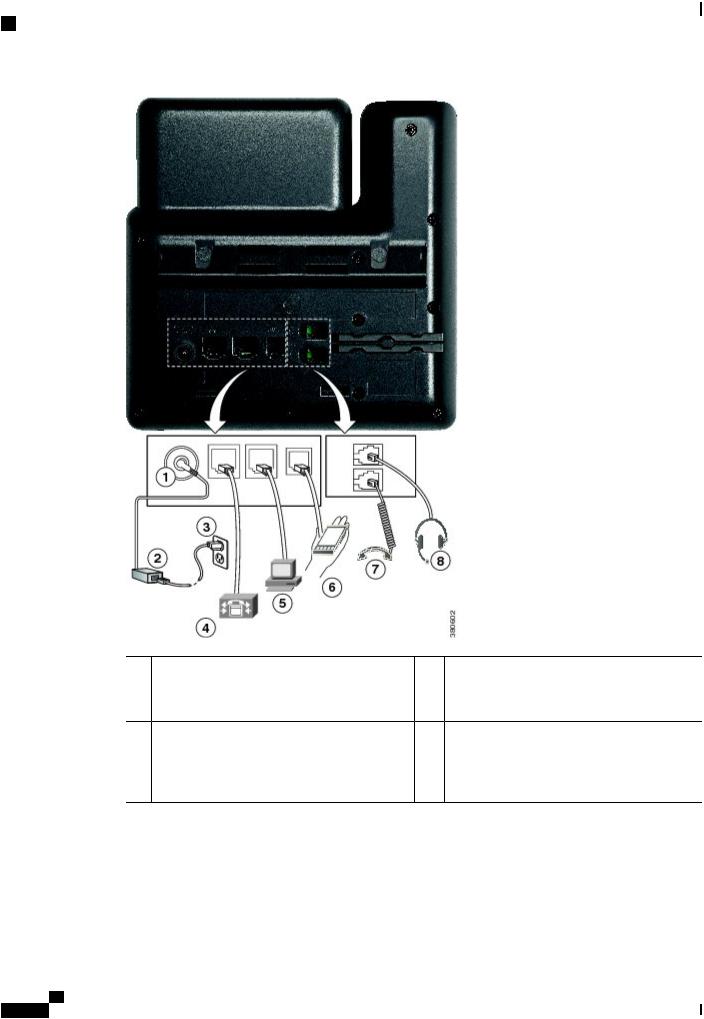
Getting Started
Phone Connections
1 |
DC adaptor port (DC48V) (optional). |
5 |
Access port (10/100 PC) connection. |
2 |
AC-to-DC power supply (optional). |
6 |
Auxiliary port (optional). |
3 |
AC power wall plug (optional). |
7 |
Handset connection. |
4 |
Network port (10/100 SW) connection. IEEE |
8 |
Analog headset connection (optional). |
|
802.3af power enabled. |
|
|
Cisco IP Phone 7821, 7841, and 7861 User Guide for Cisco Unified Communications Manager 10.0 (SIP)
2
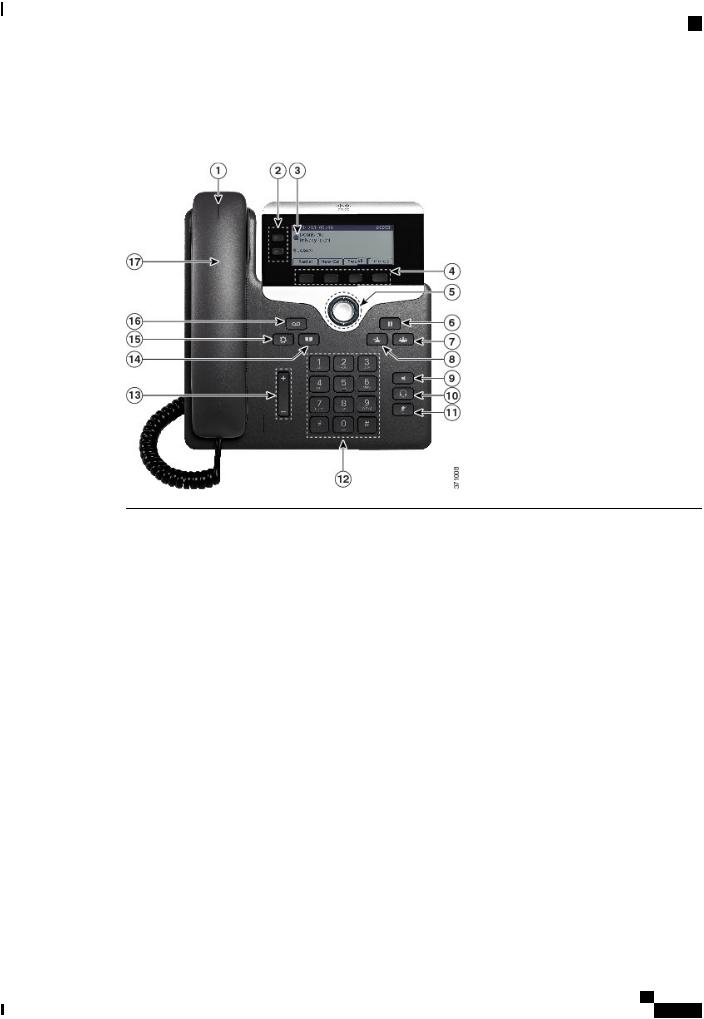
Getting Started
Buttons and Hardware
Buttons and Hardware
1 |
Handset light strip |
Indicates an incoming call (flashing red) or new voice message (steady |
|
|
red). |
Cisco IP Phone 7821, 7841, and 7861 User Guide for Cisco Unified Communications Manager 10.0 (SIP)
3
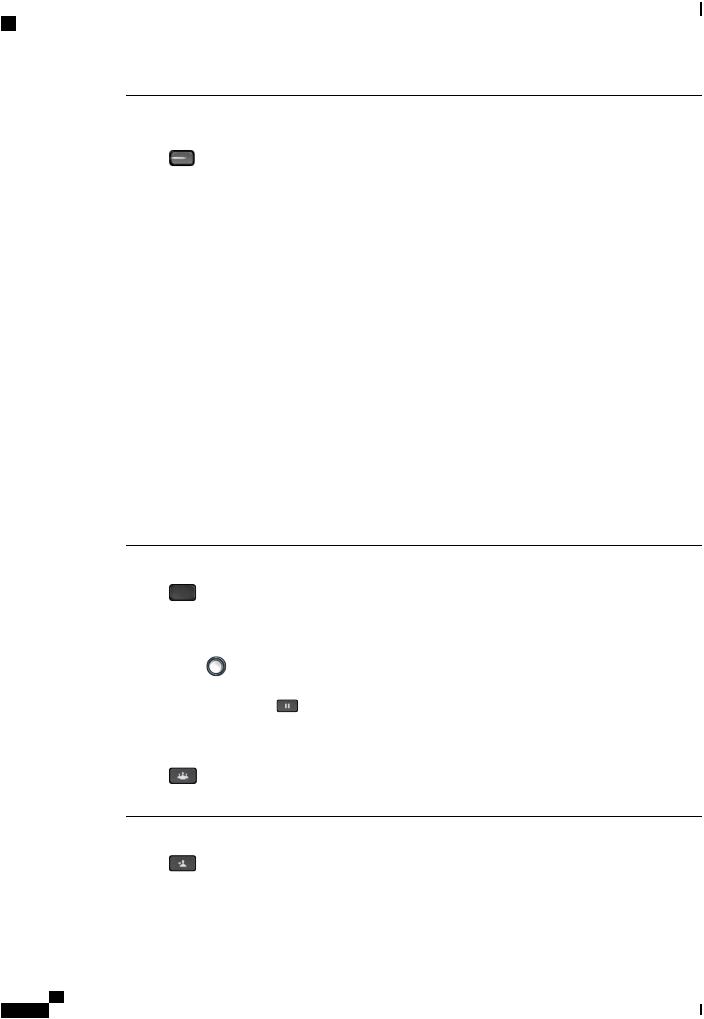
Getting Started
Buttons and Hardware
2 |
Programmable feature |
Depending on how your system administrator sets up the phone, |
|
buttons |
programmable feature buttons (on each side of the phone screen) provide |
|
|
access to: |
|
|
• Phone lines and intercom lines |
|
|
• Speed-dial numbers (speed-dial buttons, including the Line Status |
|
|
speed-dial features) |
|
|
• Web-based services (for example, a Personal Address Book button) |
|
|
• Call features (for example, a Privacy button) |
|
|
Buttons illuminate to indicate status: |
|
|
• Green, steady: Active call or two-way intercom call |
|
|
• Green, flashing: Held call |
|
|
• Amber, steady: Privacy in use, one-way intercom call, DND active, |
|
|
or logged into Hunt Group |
|
|
• Amber, flashing: Incoming call or reverting call |
|
|
• Red, steady: Remote line in use (shared line or Line Status) |
|
|
• Red, flashing: Remote line on hold |
3 |
Phone screen |
Shows information about your phone, such as directory number, active |
|
|
call and line status, call duration, softkey options, speed dials, placed calls, |
|
|
and phone menu listings. |
4 |
Softkey buttons |
Depending on how your system administrator sets up the phone, enable |
|
|
softkey options displayed on your phone screen. |
5 |
Navigation and Select |
The Navigation and Select button allows you to scroll through menus, |
|
button |
highlight items and select the highlighted item. |
|
|
|
6 |
Hold/Resumebutton |
Places an active call on hold and resumes the held call. |
7 |
Conference button |
Creates a conference call. |
8 |
Transfer button |
Transfers a call. |
Cisco IP Phone 7821, 7841, and 7861 User Guide for Cisco Unified Communications Manager 10.0 (SIP)
4
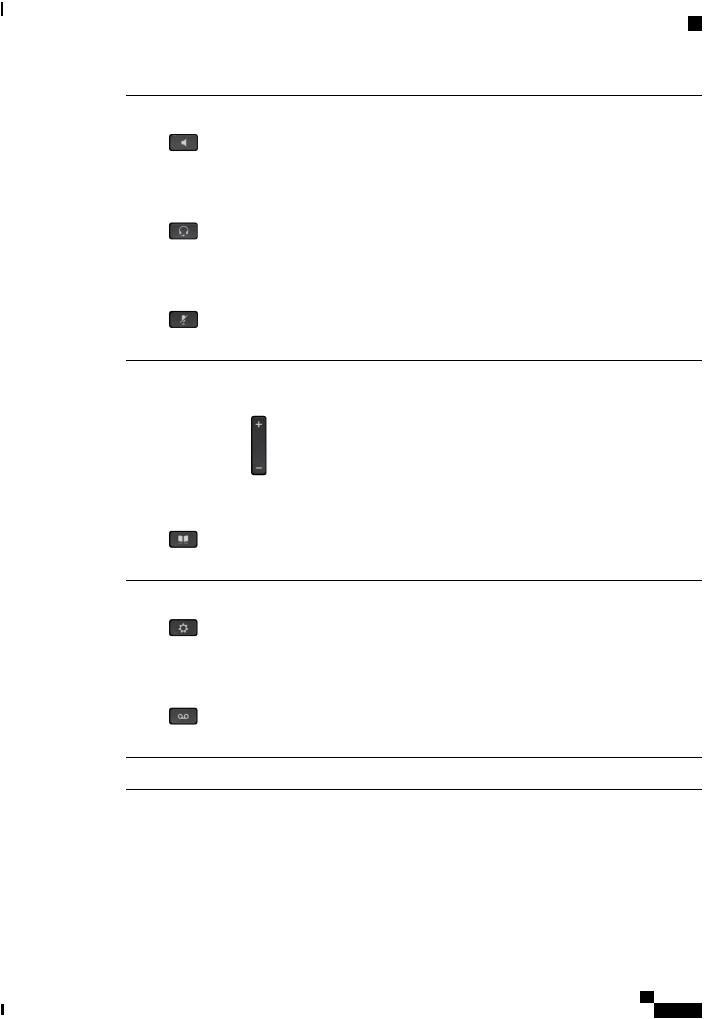
Getting Started
|
|
Buttons and Hardware |
9 |
Speakerphone button |
Toggles the speakerphone on or off. When the speakerphone is on, the |
|
|
button is lit. |
10 |
Headset button |
Toggles the headset on or off. When the headset is on, the button is lit. |
11 |
Mute button |
Toggles the microphone on or off. When the microphone is muted, the |
|
|
button is lit. |
12 |
Keypad |
Allows you to dial phone numbers, enter letters, and select menu items |
|
|
(by entering the item number). |
13 |
|
Controls the handset, headset, and speakerphone volume (off hook) and |
|
|
the ringer volume (on hook). |
|
Volume button |
|
14 |
Contacts button |
Opens or closes the Directories menu. Use the Contacts button to access |
|
|
personal and corporate directories. |
15 |
Applications button |
Opens or closes the Applications menu. Use the Applications button to |
|
|
access call history, user preferences, phone settings, accessories, subscribed |
|
|
phone services, and phone model information. |
16 |
Messages button |
Autodials your voice messaging system (varies by system). |
17 |
Handset |
Phone handset. |
Cisco IP Phone 7821, 7841, and 7861 User Guide for Cisco Unified Communications Manager 10.0 (SIP)
5
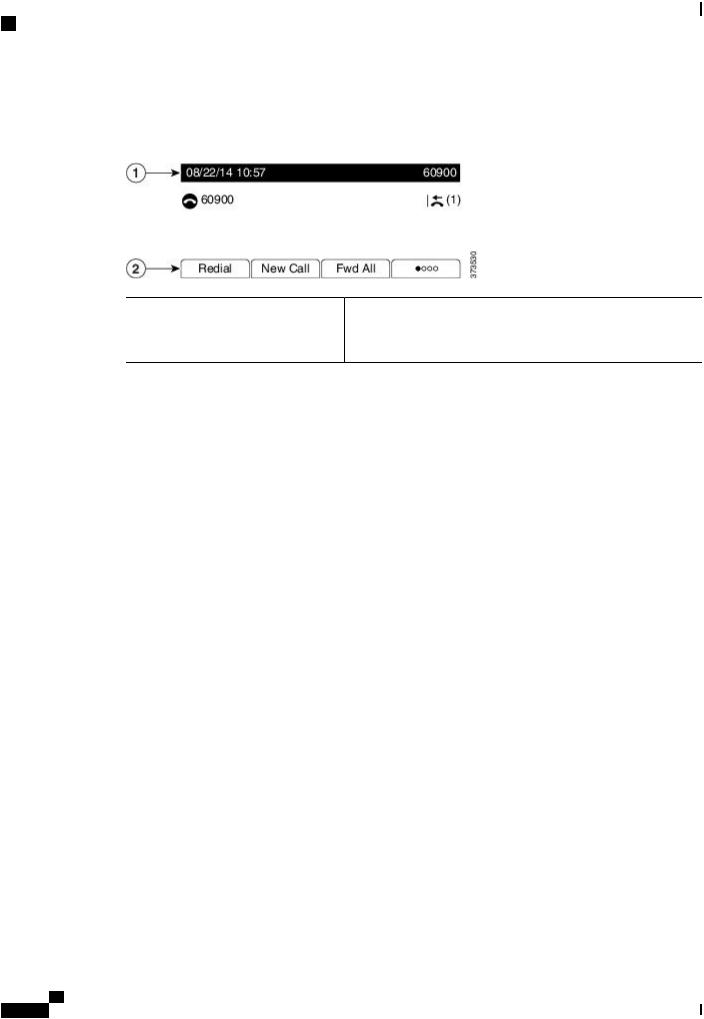
Getting Started
Phone Screen
Phone Screen
1 |
Header |
Displays date, time, and directory number. |
2 |
Softkey labels |
Display softkeys for available features or actions. |
Cisco IP Phone 7841
Phone Connections
For your phone to work, it must be connected to the corporate IP telephony network.
Cisco IP Phone 7821, 7841, and 7861 User Guide for Cisco Unified Communications Manager 10.0 (SIP)
6
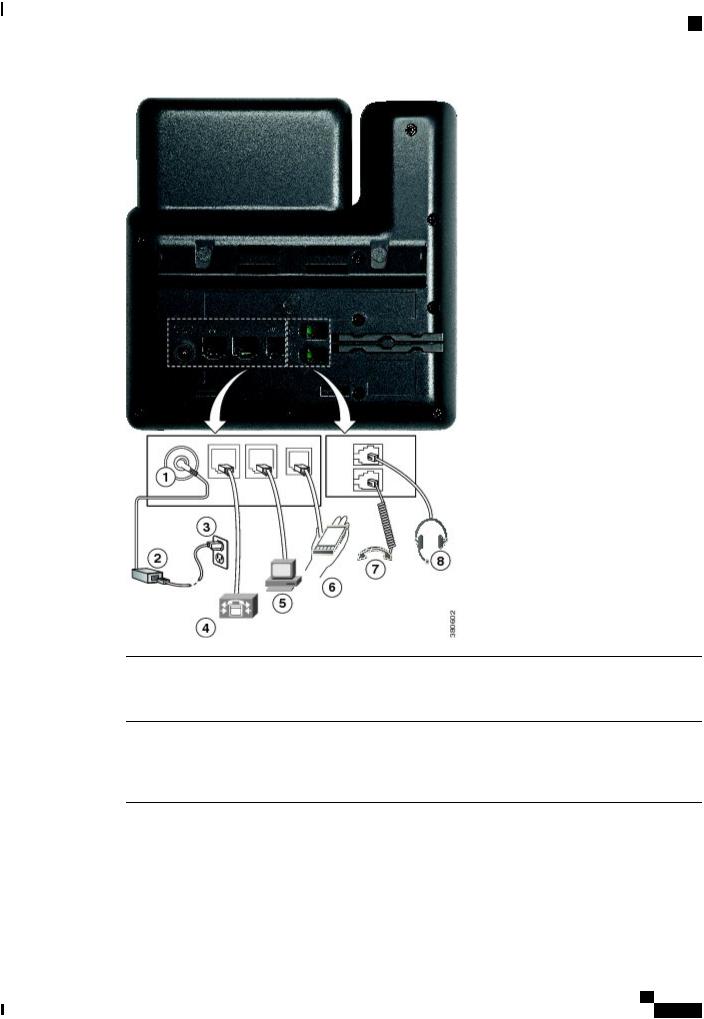
Getting Started
Phone Connections
1 |
DC adaptor port (DC48V) (optional). |
5 |
Access port (10/100/1000 PC) connection. |
2 |
AC-to-DC power supply (optional). |
6 |
Auxiliary port (optional). |
3 |
AC power wall plug (optional). |
7 |
Handset connection. |
4 |
Network port (10/100/1000 SW) connection. |
8 |
Analog headset connection (optional). |
|
IEEE 802.3af power enabled. |
|
|
Cisco IP Phone 7821, 7841, and 7861 User Guide for Cisco Unified Communications Manager 10.0 (SIP)
7
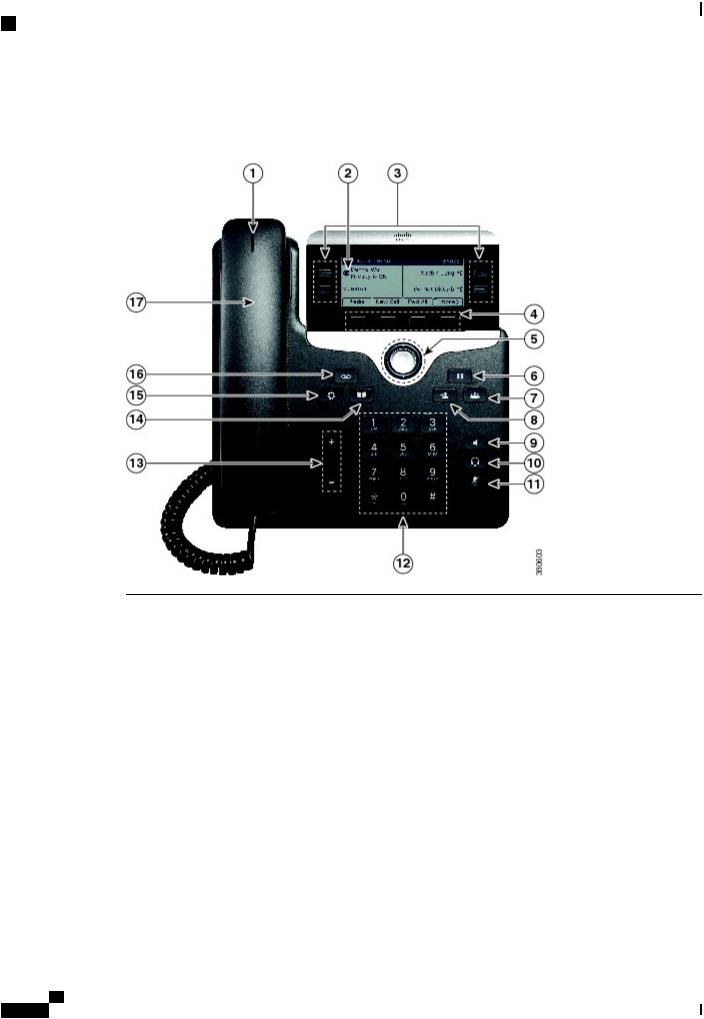
Getting Started
Buttons and Hardware
Buttons and Hardware
1 |
Handset light strip |
Indicates an incoming call (flashing red) or new voice message (steady |
|
|
red). |
Cisco IP Phone 7821, 7841, and 7861 User Guide for Cisco Unified Communications Manager 10.0 (SIP)
8
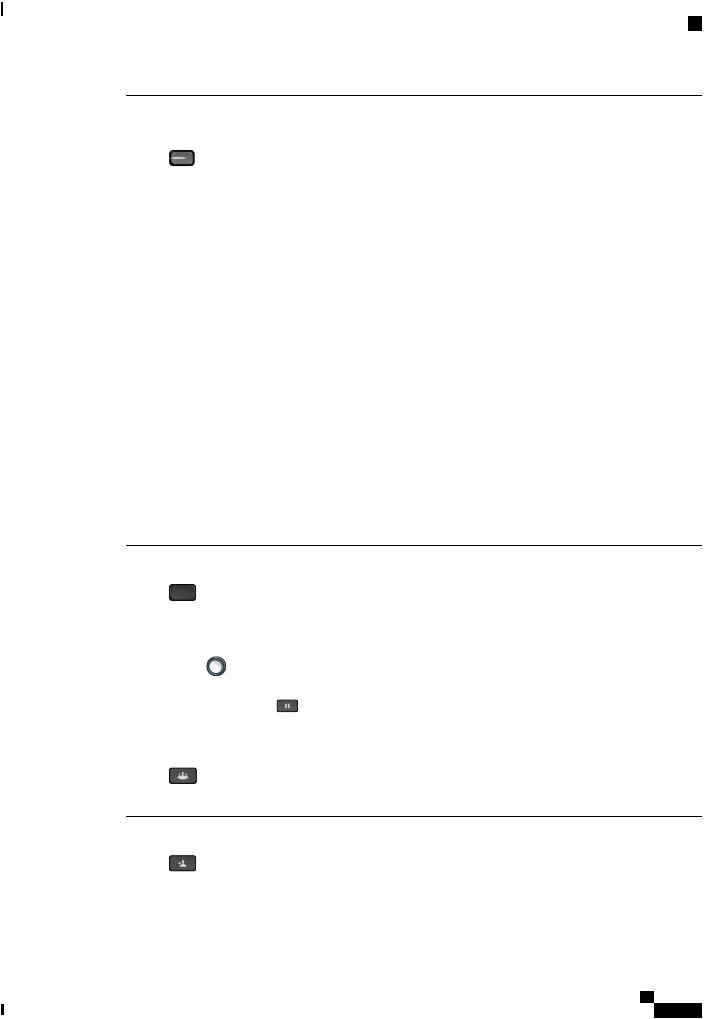
Getting Started
Buttons and Hardware
2 |
Programmable feature |
Depending on how your system administrator sets up the phone, |
|
buttons |
programmable feature buttons (on each side of the phone screen) provide |
|
|
access to: |
|
|
• Phone lines and intercom lines |
|
|
• Speed-dial numbers (speed-dial buttons, including the Line Status |
|
|
speed-dial features) |
|
|
• Web-based services (for example, a Personal Address Book button) |
|
|
• Call features (for example, a Privacy button) |
|
|
Buttons illuminate to indicate status: |
|
|
• Green, steady: Active call or two-way intercom call |
|
|
• Green, flashing: Held call |
|
|
• Amber, steady: Privacy in use, one-way intercom call, DND active, |
|
|
or logged into Hunt Group |
|
|
• Amber, flashing: Incoming call or reverting call |
|
|
• Red, steady: Remote line in use (shared line or Line Status) |
|
|
• Red, flashing: Remote line on hold |
3 |
Phone screen |
Shows information about your phone, such as directory number, active |
|
|
call and line status, call duration, softkey options, speed dials, placed calls, |
|
|
and phone menu listings. |
4 |
Softkey buttons |
Depending on how your system administrator sets up the phone, enable |
|
|
softkey options displayed on your phone screen. |
5 |
Navigation and Select |
The Navigation and Select button allows you to scroll through menus, |
|
button |
highlight items and select the highlighted item. |
|
|
|
6 |
Hold/Resumebutton |
Places an active call on hold and resumes the held call. |
7 |
Conference button |
Creates a conference call. |
8 |
Transfer button |
Transfers a call. |
Cisco IP Phone 7821, 7841, and 7861 User Guide for Cisco Unified Communications Manager 10.0 (SIP)
9
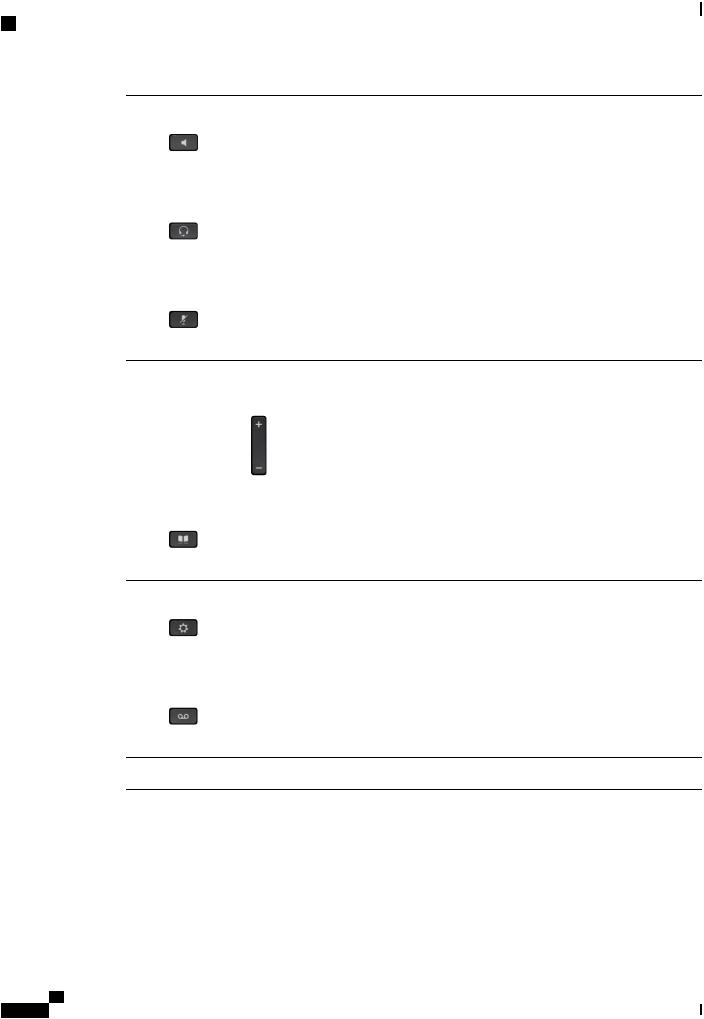
Getting Started
Buttons and Hardware
9 |
Speakerphone button |
Toggles the speakerphone on or off. When the speakerphone is on, the |
|
|
button is lit. |
10 |
Headset button |
Toggles the headset on or off. When the headset is on, the button is lit. |
11 |
Mute button |
Toggles the microphone on or off. When the microphone is muted, the |
|
|
button is lit. |
12 |
Keypad |
Allows you to dial phone numbers, enter letters, and select menu items |
|
|
(by entering the item number). |
13 |
|
Controls the handset, headset, and speakerphone volume (off hook) and |
|
|
the ringer volume (on hook). |
|
Volume button |
|
14 |
Contacts button |
Opens or closes the Directories menu. Use the Contacts button to access |
|
|
personal and corporate directories. |
15 |
Applications button |
Opens or closes the Applications menu. Use the Applications button to |
|
|
access call history, user preferences, phone settings, and phone model |
|
|
information. |
16 |
Messages button |
Autodials your voice messaging system (varies by system). |
17 |
Handset |
Phone handset. |
Cisco IP Phone 7821, 7841, and 7861 User Guide for Cisco Unified Communications Manager 10.0 (SIP)
10
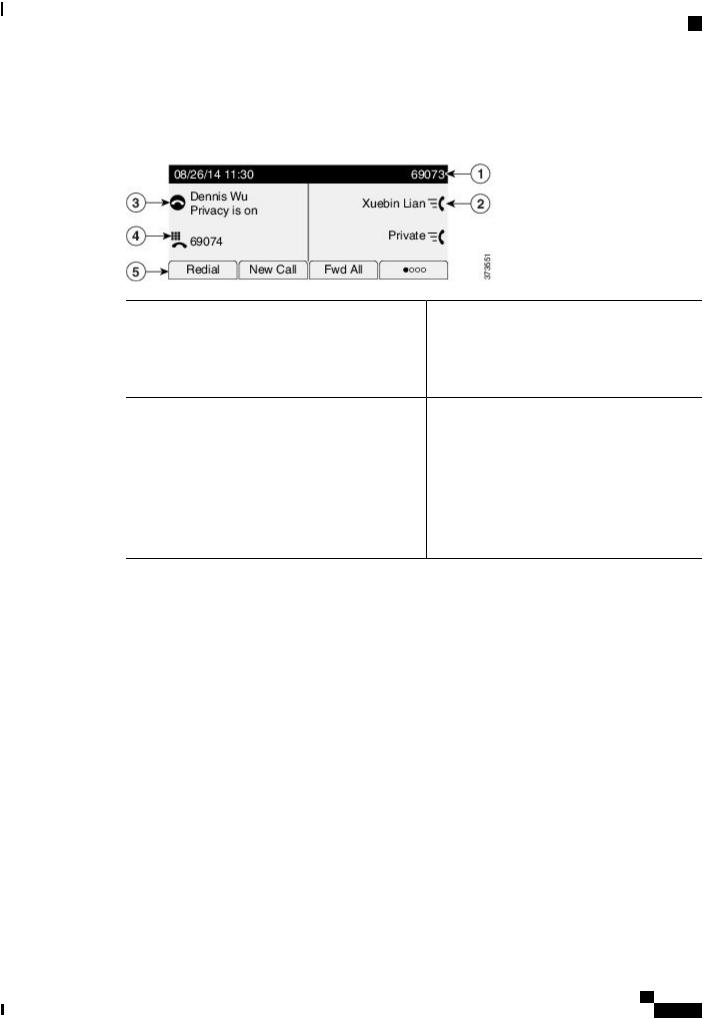
Getting Started
Phone Screen
Phone Screen
1 |
Header |
Displays date, time, and directory number. |
2 |
Line text label with icon |
Displays text label and icon for phone or intercom |
|
|
line, speed-dial numbers, or services, depending |
|
|
on your configuration. |
3 |
Primary line details and other phone information |
Displays line label and call details for the primary |
|
|
line, and other phone information such as placed |
|
|
calls, speed dials, and phone menu listings. |
4Secondary line details and other phone information
Displays line label and call details for the secondary line, and other phone information such as placed calls, speed dials, and phone menu listings.
5 |
Softkey labels |
Display softkeys for available features or actions. |
Cisco IP Phone 7861
Phone Connections
For your phone to work, it must be connected to the corporate IP telephony network.
Cisco IP Phone 7821, 7841, and 7861 User Guide for Cisco Unified Communications Manager 10.0 (SIP)
11
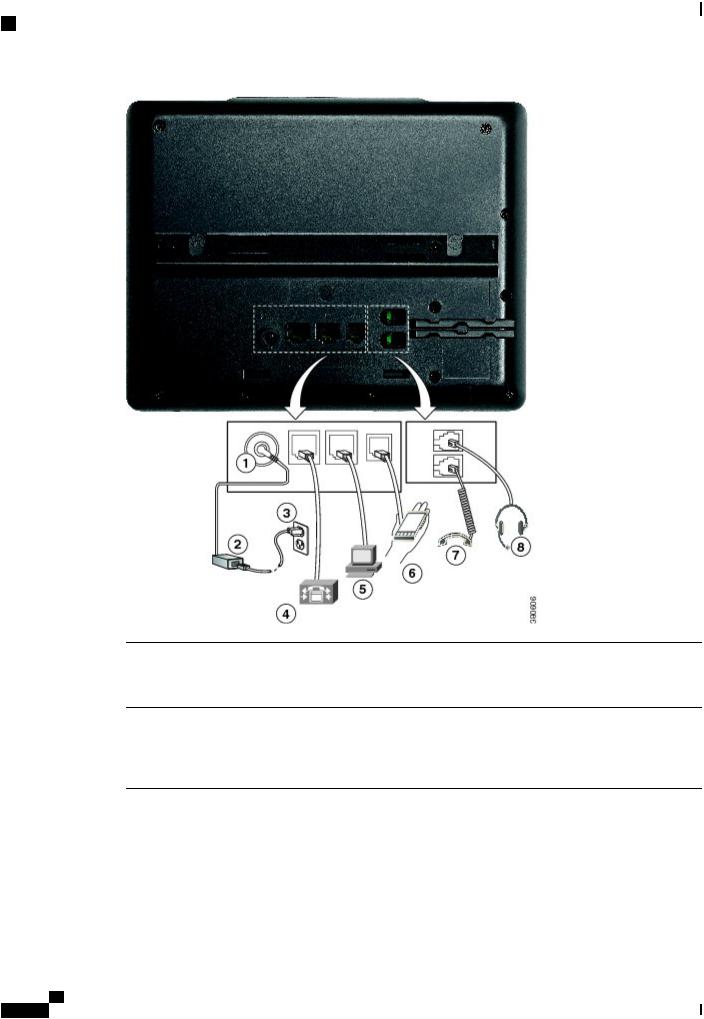
Getting Started
Phone Connections
1 |
DC adaptor port (DC48V). |
5 |
Access port (10/100 PC) connection. |
2 |
AC-to-DC power supply (optional). |
6 |
Auxiliary port. |
3 |
AC power wall plug (optional). |
7 |
Handset connection. |
4 |
Network port (10/100 SW) connection. IEEE |
8 |
Analog headset connection (optional). |
|
802.3af power enabled. |
|
|
Cisco IP Phone 7821, 7841, and 7861 User Guide for Cisco Unified Communications Manager 10.0 (SIP)
12
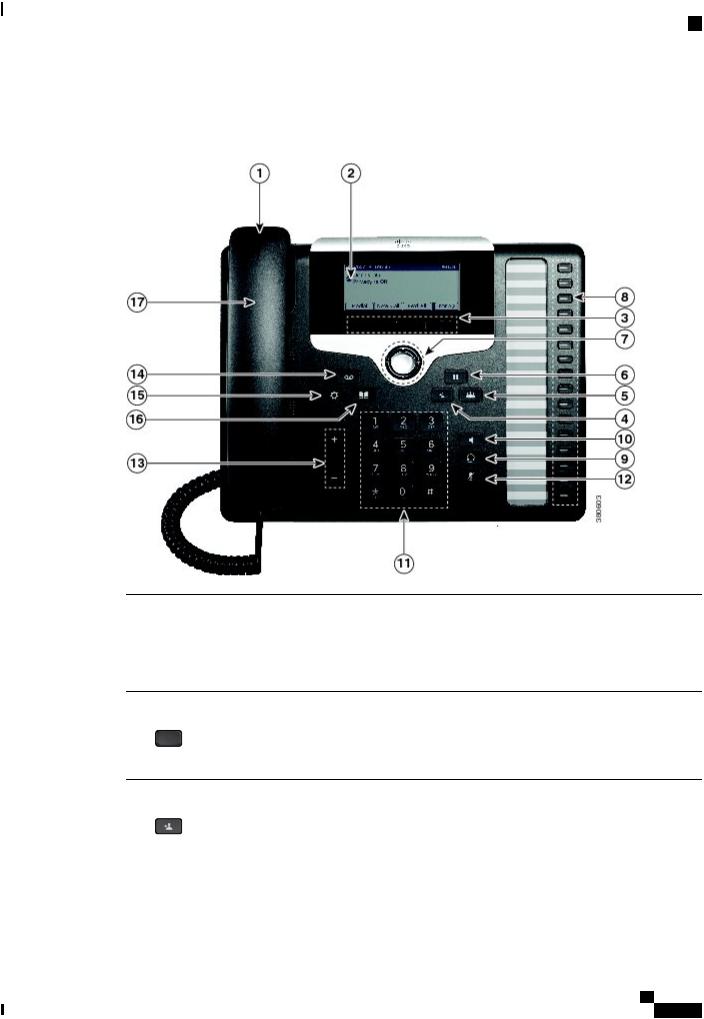
Getting Started
Buttons and Hardware
Buttons and Hardware
1 |
Handset light strip |
Indicates an incoming call (flashing red) or new voice message (steady red). |
2 |
Phone screen |
Shows information about your phone, such as directory number, active call |
|
|
and line status, call duration, softkey options, speed dials, placed calls, and |
|
|
phone menu listings. |
3 |
Softkey buttons |
Depending on how your system administrator sets up the phone, enable |
|
|
softkey options displayed on your phone screen. |
4 |
Transfer button |
Transfers a call. |
Cisco IP Phone 7821, 7841, and 7861 User Guide for Cisco Unified Communications Manager 10.0 (SIP)
13

Getting Started
Buttons and Hardware
5 Conference button |
Creates a conference call. |
6 |
Hold/Resume button |
Places an active call on hold and resumes the held call. |
7 |
Navigation and Select |
The Navigation and Select button allows you to scroll through menus, |
|
button |
highlight items and select the highlighted item. |
|
|
|
8 |
Programmable feature |
Depending on how your system administrator sets up the phone, |
|
buttons |
programmable feature buttons provide access to: |
• Phone lines and intercom lines
• Speed-dial numbers (speed-dial buttons, including the Line Status speed-dial features)
• Web-based services (for example, a Personal Address Book button)
• Call features (for example, a Privacy button)
Buttons illuminate to indicate status:
•Green, steady: Active call or two-way intercom call
•Green, flashing: Held call
•Amber, steady: Privacy in use, one-way intercom call, DND active, or logged into Hunt Group
•Amber, flashing: Incoming call or reverting call
•Red, steady: Remote line in use (shared line or Line Status)
•Red, flashing: Remote line on hold
9 Headset button |
Toggles the headset on or off. When the headset is on, the button is lit. |
10 Speakerphone button |
Toggles the speakerphone on or off. When the speakerphone is on, the button |
|
is lit. |
11 Keypad |
Allows you to dial phone numbers, enter letters, and select menu items (by |
|
entering the item number). |
Cisco IP Phone 7821, 7841, and 7861 User Guide for Cisco Unified Communications Manager 10.0 (SIP)
14

Getting Started
|
|
Phone Screen |
12 |
Mute button |
Toggles the microphone on or off. When the microphone is muted, the button |
|
|
is lit. |
13 |
|
Controls the handset, headset, and speakerphone volume (off hook) and the |
|
|
ringer volume (on hook). |
|
Volume button |
|
14 |
Messages button |
Autodials your voice messaging system (varies by system). |
15 |
Applications button |
Opens or closes the Applications menu. Use the Applications button to |
|
|
access call history, user preferences, phone settings, accessories, subscribed |
|
|
phone services, and phone model information. |
16 |
Contacts button |
Opens or closes the Directories menu. Use the Contacts button to access |
|
|
personal and corporate directories. |
17 |
Handset |
Phone handset. |
Phone Screen
1Header
2Line details and other phone information
Displays date, time, and directory number.
During a call, displays details for the active line. If not on a call, displays line text label and other information such as placed calls, speed dials, and phone menu listings.
3 Softkey labels |
Display softkeys for available features or actions. |
Cisco IP Phone 7821, 7841, and 7861 User Guide for Cisco Unified Communications Manager 10.0 (SIP)
15

Getting Started
Power Requirements
Power Requirements
The following Cisco-approved power adaptors must be used with the Cisco IP Phones 7821, 7841, and 7861:
•Phihong Adaptor (PSC18U-480); Rating: 48 VDC 0.38A
•Delta Adaptor (EADP-18VB B); Rating: 48 VDC 0.375A
Power Save and Power Save Plus
There are two levels of energy-saving modes that your system administrator can set up:
•Power Save: The phone display goes blank when not in use for a period of time, reducing the power requirements.
•Power Save Plus: The phone display goes blank, turning the phone off and on at predetermined times. The power to the phone is significantly reduced.
Power Save
Depending on how your system administrator set up your phone, the phone display may go into a power-save mode (the phone screen appears blank).
To turn on the phone display, press any button, touch the blank phone screen, or pick up the handset.
Power Save Plus
Your phone supports the Cisco EnergyWise (EW) program, also known as Power Save Plus. Your system administrator sets up sleep (power down) and wake (power up) times for your phone to save energy. If your phone goes into the Power Save Plus mode, the Select button is lit white.
Ten minutes before the scheduled sleep time, the Select button lights up and you receive a message that your phone will power off at a specific time. If enabled by your system administrator, you also hear your ringtone play. The ringtone plays according to the following schedule:
•At 10 minutes before power off, the ringtone plays four times
•At 7 minutes before power off, the ringtone plays four times
•At 4 minutes before power off, the ringtone plays four times
•At 30 seconds before power off, the ring tone plays 15 times or until the phone powers off
If your phone is inactive (idle) at the sleep time, you see a message to remind you that your phone is about to power down. To keep the phone active, you need to press OK in the message or any key on the phone. If you do not press the button or any key, your phone powers down.
If your phone is active (for example, on a call), your phone waits until it has been inactive for a period of time before telling you of the pending power shutdown. Before the shutdown happens, you see a message to remind you that your phone is about to power off.
Cisco IP Phone 7821, 7841, and 7861 User Guide for Cisco Unified Communications Manager 10.0 (SIP)
16

Getting Started
Additional Information
After your phone goes to sleep, press Select to wake up your phone. After the phone is inactive for a period of time, a message displays to alert you that the phone is about to power down. At the configured wake time, your phone powers up.
Wake and sleep times are also linked to the configured days that you normally work. If your requirements change (for example, your work hours or work days change), contact your system administrator to have your phone reconfigured.
For more information about EnergyWise and your phone, contact your system administrator.
Additional Information
•You can access the Cisco website at this URL: http://www.cisco.com/
•Cisco IP Phone 7821, 7841, and 7861 user documentation: http://www.cisco.com/en/US/products/ps13220/tsd_products_support_series_home.html
•Licensing information: http://www.cisco.com/en/US/products/ps13220/products_licensing_information_listing.html
•Cisco international web sites:
Allows access to international Cisco web sites from www.cisco.com by clicking the Worldwide [change] link at the top of the web page.
•Connect your Cisco IP phone to your LAN using an Ethernet cable to enable full functionality of your Cisco IP phone. If your Ethernet port is equipped with Power over Ethernet (PoE), your Cisco IP phone can be powered through the LAN port. Do not extend the LAN Ethernet cable outside the building.
Cisco IP Phone 7821, 7841, and 7861 User Guide for Cisco Unified Communications Manager 10.0 (SIP)
17

Getting Started
Additional Information
Cisco IP Phone 7821, 7841, and 7861 User Guide for Cisco Unified Communications Manager 10.0 (SIP)
18
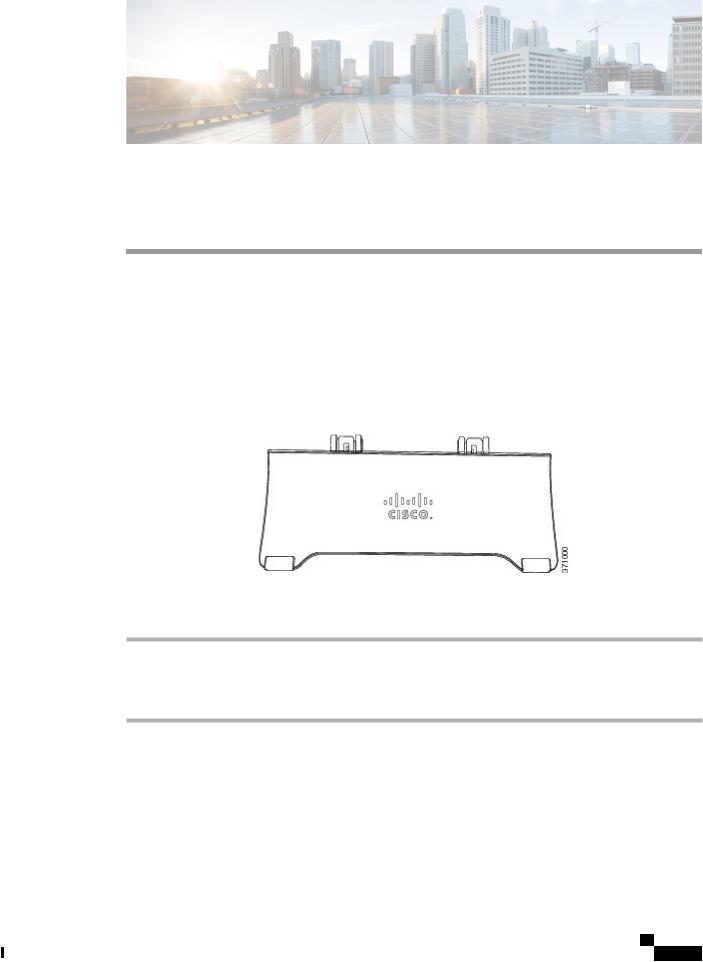
C H A P T E R 2
Phone Setup
• Connect Footstand, page 19
• Adjust the Handset Rest, page 19
Connect Footstand
If your phone is placed on a table or desk, connect the footstand to the back of the phone.
Procedure
Step 1 Insert the curved connectors into the lower slots.
Step 2 Lift the footstand until the connectors snap into the upper slots.
Note Connecting and disconnecting the footstand may require a little more force than you expect.
Adjust the Handset Rest
If your phone is wall-mounted, you may need to adjust the handset rest to ensure that the receiver does not slip out of the cradle.
Cisco IP Phone 7821, 7841, and 7861 User Guide for Cisco Unified Communications Manager 10.0 (SIP)
19
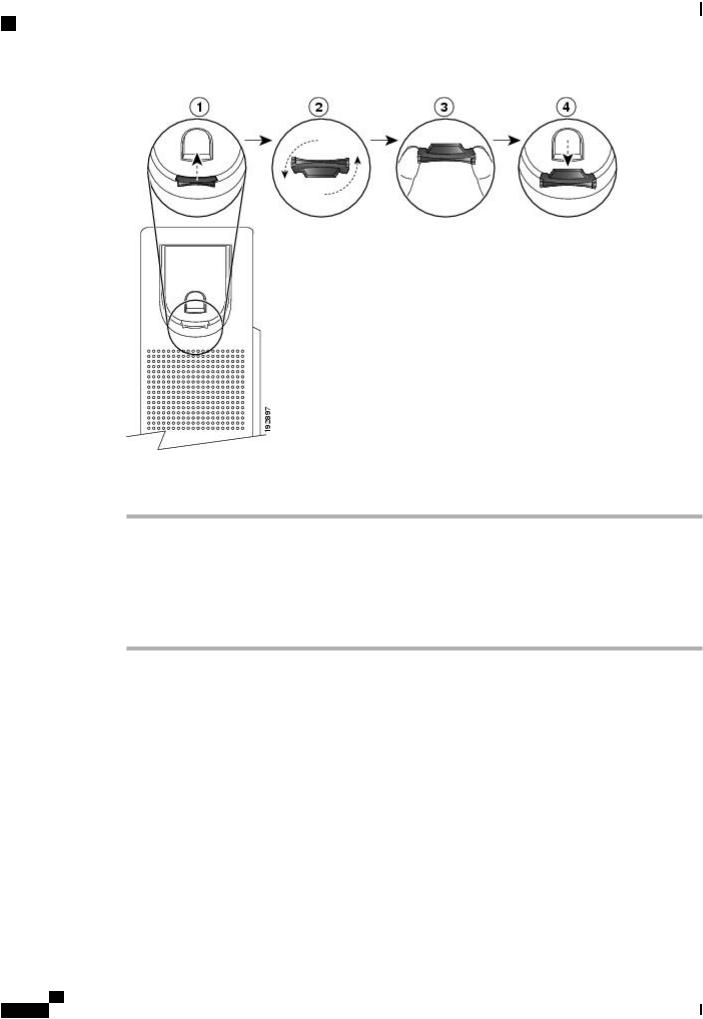
Phone Setup
Adjust the Handset Rest
Procedure
Step 1 Remove the handset from the cradle and pull the plastic tab from the handset rest.
Step 2 Rotate the tab 180 degrees.
Step 3 Hold the tab between two fingers, with the corner notches facing you.
Step 4 Line up the tab with the slot in the cradle and press the tab evenly into the slot. An extension protrudes from the top of the rotated tab.
Step 5 Return the handset to the handset rest.
Cisco IP Phone 7821, 7841, and 7861 User Guide for Cisco Unified Communications Manager 10.0 (SIP)
20

C H A P T E R 3
Basic Operations
• |
Clean the Phone Display, page 21 |
|
• |
Make Calls, page 22 |
|
• |
Answer Calls, page 24 |
|
• |
Automatically Answer Calls, page |
25 |
• |
Respond to Call Waiting Notification, page 26 |
|
• |
Manage Calls, page 27 |
|
• |
Mute Phone, page 29 |
|
• |
Monitor and Record Calls , page 29 |
|
• |
Hold Calls, page 29 |
|
• |
Setup Call Back Notification, page |
30 |
• |
Call Park, page 31 |
|
• |
Manage Intercom Calls, page 32 |
|
• |
View Phone Information, page 33 |
|
• |
Sign In To the Cisco Unified Communications Self Care Portal, page 34 |
|
Clean the Phone Display
Phone displays that are not touchscreens can be easily cleaned.
Procedure
Wipe the screen with a soft, dry cloth.
Caution Use only a soft, dry cloth to wipe the phone display. Do not use any liquids or powders on the phone because they can contaminate phone components and cause failures.
Cisco IP Phone 7821, 7841, and 7861 User Guide for Cisco Unified Communications Manager 10.0 (SIP)
21
